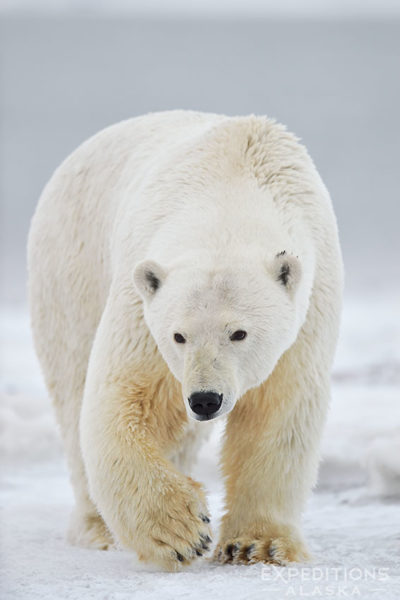
Large adult male polar bears can weigh over 1400lbs.
Seriously? How big?
We’ve all heard polar bears are the largest terrestrial carnivore, right? We’ll side-step the rather silly idea of labelling Ursus maritimus (Sea bear), a marine mammal, as a “land-based carnivore ” for the moment. Instead consider the point behind it. Polar bears are the largest predator on land. This begs the question “just how big are polar bears?”
That’s a tough question to answer, for a number of reasons.
What does “big” mean? How tall? How heavy? What’s the volume?
Generally animals are measured by weight. Largely because weight can be such a good indicator of health and particularly population health. So we’ll consider the question (for now) of “How heavy is a polar bear?”.
Firstly, the weight of a wild animal often varies drastically throughout the year. Unlike humans with a reasonably static year-round diet, wild animals tend to follow the cycles of their environment. Growing seasons yield more productivity and, for predators, that will generally mean more prey. So weights go up. A lot.
But not just with cycles and fluctuations. Predators are often capable of gorging themselves when they come across a good food source and bears are one of the masters of this art. A polar bear’s stomach can hold up to 20% of its own mass.
Think about that. A 1000lb bear can 200 lbs worth of food in a single meal. That same 1000lb polar bear now weighs 1200lbs.
They can do this remarkably quickly too. A hungry polar bear can put on 10% of its weight in about 30 minutes.
If we ask “how much does a polar bear weigh”, the answer can vary greatly on when we weigh it.
And what about during lean times, such as summer when the thin ice pack retreats out over the deeper water and hunting becomes more difficult? That 1000lb polar bear might drop it’s overall weight down to 600lb.
Similarly a sow with cubs in tow might be spending far more energy hunting and providing for the cubs than she is able to store up for herself. Ian Stirling (Canadian researcher) recounts a female bear weighing about 210 pounds when she had 2 yearling cubs with her in early December. By spring she’d lost the cubs and when he weighed her again in August she tired the scales at just over 990 lbs.
Another factor is the individual bear. Sexual dimorphism is the term used to describe “morphological, physiological, and behavioral differences between males and females of the same species”. Male polar bears, for example, weigh as much as 260% more than female bears, and the difference is sometimes greater than 400%.
That’s a pretty broad range.
What is not true, though, is a regional difference in polar bear sizes. Most research shows that polar bears across their circumpolar range tend to weigh fairly consistently. Differences that are noted are found to arise from sample sizes being too small or ecological differences such as variations in population pressures such as food availability or harvesting/hunting.
Researchers are seeing consistently declining bear sizes in places like the Western Hudson Bay due climate change.
So then just how much DOES a polar bear weigh?
Any answer for how much does a polar bear weigh is a little bit like asking how much does a human being weigh. Shaquille O’Neal in his prime weighed 300lbs and 5000m world record holder Kenenisa Bekele weighs around 125lbs. Kenyan Olympic gold medalist Faith Kipyegon weighs around 95lbs.
All world class professional athletes in their prime. The variance is drastic.
But we can have a look at some numbers with bears and get something of an idea. I just think it’s important to put the very real caveats up front that weights and sizes with no context aren’t very meaningful.
Polar bear cubs are born weighing between 1-2lbs, generally 1-1.5lbs. Even at birth males tend to be slightly larger than females. When they leave the den a few short months later they may weigh 25-35lbs and at one year 200-350lbs. By the end of the second year the male cubs are often taller than their mother and weigh as much as 400lbs. That’s a pretty serious weight-gain.
As adults, male polar bears may weigh anywhere from 750-1450lbs and some specimens have been recorded far larger. I’ve seen articles suggesting a 2200 behemoth was shot in the Chukchi Sea but as far as I know this isn’t a verifiable report.
Male polar bears generally might stand 8’ tall, and some are as tall as 10’ tall. Reports of polar bears being 12’ tall are anecdotal. Those numbers tend to come from measuring a stretched out hide, not an actual standing bear.
Adult female polar bears generally weigh as much as 950lbs, though 330-550lbs is a common weight. Super-sized pregnant females weighing 1100lbs have been measured though.
How big is a polar bear? Big enough.
For more info and photos and cool tales about polar bears, download this free Polar Bears of Alaska eBook. Available as a PDF or iBooks, tons of photos and information about this amazing animal. If you’ve read all the way to here on this article, I’m sure you’ll love the eBook.
And if you’re still curious about hot big polar bears are, consider joining our October Polar Bear Photo Tour and see for yourself.
Cheers
Carl



